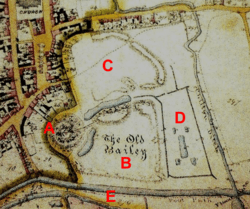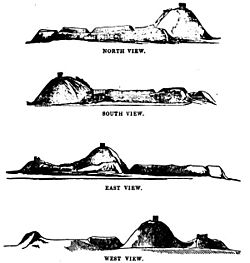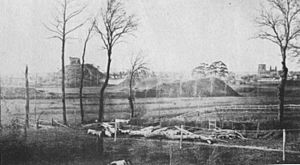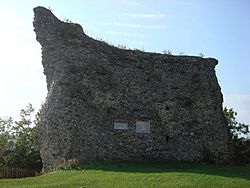Clare Castle facts for kids
Quick facts for kids Clare Castle |
|
|---|---|
| Clare, Suffolk, England | |
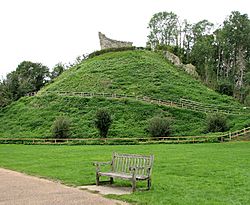
Motte of Clare Castle
|
|
| Coordinates | 52°04′36″N 0°34′58″E / 52.0768°N 0.5829°E |
| Type | Motte and bailey |
| Site information | |
| Owner | Clare Town Council |
| Open to the public |
Yes |
| Condition | Ruined; motte and outer bailey survive |
| Site history | |
| Materials | Flint and rubble |
Clare Castle is an old, ruined castle in Clare, Suffolk, England. It was built a long time ago, right after the Norman Conquest in 1066. A powerful person named Richard Fitz Gilbert built it.
The castle started as a "motte and bailey" design. This means it had a big earth mound (the motte) with a tower on top. It also had a walled area (the bailey) below. Later, parts of the castle were made stronger with stone.
In the 1300s, Elizabeth de Clare lived here. She was one of the richest women in England. She had a large household at the castle. Over time, the castle became property of the Crown. By the 1600s, it was no longer used.
Today, you can still see the tall earth mound and parts of the old walls. A railway line was built through the castle in 1867. This line is now gone. The castle ruins are a protected historical site. They are now part of a public park.
Contents
History of Clare Castle
Building the Castle (1000s–1200s)
After the Normans took over England in 1066, William the Conqueror gave land to his followers. One of them was Richard Fitz Gilbert. He received land in Kent, Suffolk, and Essex.
Richard built two castles to protect his new lands. One was Tonbridge Castle in Kent. The other was Clare Castle in Suffolk. We don't know the exact date it was built. But records mention the castle by 1090. Suffolk was a very rich part of England back then.
Clare Castle was built near the River Stour. It was a "motte and bailey" castle. This type of castle has a large earth mound (the motte). It also has one or more walled areas (the baileys). Clare Castle had two baileys.
The motte is very wide at its base, about 850 feet (259 meters). It stands 100 feet (30 meters) tall. The top of the motte is flat. The two baileys stretched out from the motte. They were protected by deep ditches and strong wooden fences. A bridge or drawbridge connected the inner and outer baileys.
The castle was built where an old Anglo-Saxon house once stood. This showed that the Normans were now in charge. Clare Castle was the main base for the Clare family's lands. It was important for defense. It also showed how important and powerful the lord was.
The castle was surrounded by three large deer parks. These were areas where deer lived. One park, called Great Park, was set up by 1090. Like many big castles, Clare also had a religious building nearby. Richard de Clare, 6th Earl of Gloucester started Clare Priory in 1249. It was close to the castle and became home to many friars.
A new stone tower, called a keep, was likely built in the 1200s. It was a round tower with strong, thick walls. The inner bailey was also made stronger with new stone walls. These walls were 20 to 30 feet (6 to 9 meters) tall. They were built on top of the older earth banks. The walls and keep were made of flint and rubble.
During this time, local knights and soldiers guarded the castle. They were given land in exchange for their service. This was called the "castle-guard" system.
Life at the Castle (1300s)
By the early 1300s, the town of Clare had about 600 people. The de Clare family owned land all over England. But their main properties in Suffolk were around Clare Castle.
The castle passed down through the de Clare family. In 1314, Gilbert de Clare, 8th Earl of Gloucester died in battle. His sisters inherited the castle. Elizabeth de Clare received the castle and its lands. She was one of the richest women in England. Elizabeth lived at Clare Castle from 1322 to 1360. It was her main home.
The castle was very well developed by this time. You could reach it through three gates. These were called Nethergate, Redgate, and Dernegate. The castle itself had four stone towers. They protected the entrance to the inner bailey and the keep. Their names were Auditorstower, Maidenstower, Constabletower, and Oxfordtower.
Elizabeth built a special room for herself in 1346-47. The castle also had a beautiful water-garden. This garden was part of the moat on the east side. It might have had a fountain. It was probably designed in a neat, geometric shape. There were also vineyards and orchards around the castle. The three deer parks were still used. Deer were moved between them as they grew.
The castle and its lands allowed the owners to live a very rich life. Elizabeth had an income of about £3,500 a year. Most of this money was spent on her household at Clare. Over £1,750 was spent on food and drinks. This included fancy foods like swans, salmon, and German wines. Some goods were bought locally. But others, like furs, spices, cloth, and wine, were brought in from big markets.
The staff at Clare Castle included many different people. There were falconers, tailors, chaplains, and goldsmiths. About 30 knights and squires also supported the household. The castle's bakers could make over 2,300 loaves of bread a day. On average, about 900 gallons (4,091 liters) of ale were brewed every five days.
Later Years and Today (1400s–Present)
After Elizabeth de Clare died, Clare Castle changed hands several times. It passed to the Mortimers of Wigmore. When Edmund Mortimer, 5th Earl of March got the castle in 1405, it was in good condition.
Later, the Mortimers were involved in the Wars of the Roses. After Edmund died in 1425, the castle went to Richard of York, 3rd Duke of York. Then it went to his son, Edward IV, and finally to the Crown. In 1461, King Edward IV gave the castle to his mother, Cecily Neville. She used the castle, but it was not her main home.
During this time, the castle started to fall apart. People probably took stones from the castle to use for other buildings. This part of England did not have much stone. Later, Edward VI gave the castle to Sir John Checke. Then it went back to Mary I. After Mary, Sir Gervase Elwes owned it. His family kept it until the 1800s. Around 1720, the remaining walls of the inner bailey were destroyed.
In 1867, a railway line was built right through the castle. It cut across the inner bailey. This was to make space for a new train station. The railway line closed in 1967.
Today, the castle has a large earth mound (the motte). Part of the old keep still stands on top of it. You can also see parts of the outer bailey earthworks. Some pieces of the inner bailey stone wall are still there.
The old train station and castle grounds are now a beautiful country park. It is called Clare Castle Country Park. Old moats are filled with water. The park is also crossed by the Stour Valley Path. The park opened in 1972. In 2014, the keep and curtain wall were repaired. In 2015, the Clare Town Council took over managing the park. Volunteers help to keep the park nice. The castle is a protected historical site in the UK.
Images for kids



